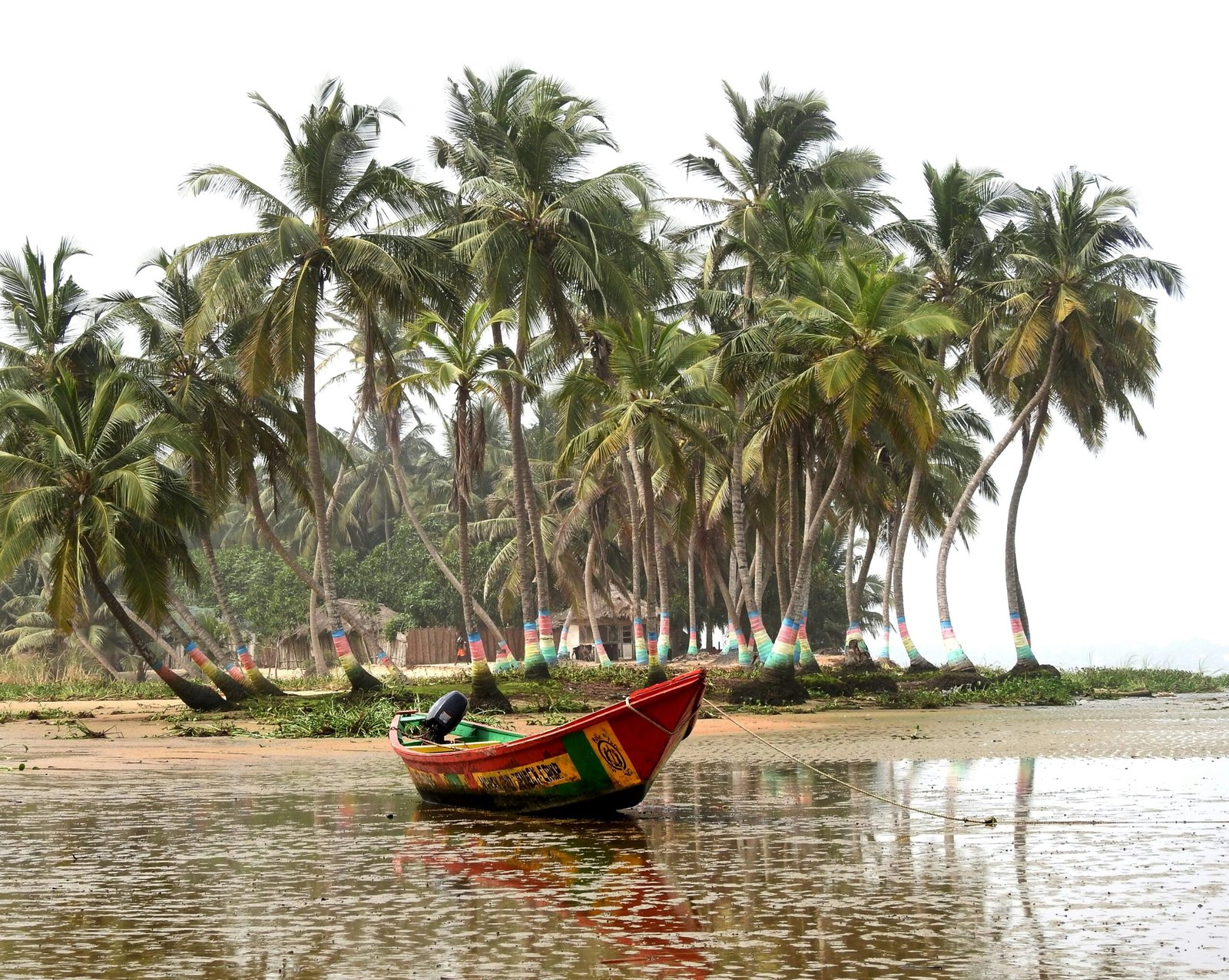
Introduction
Ghana, located on the western coast of Africa, is a country rich in history and culture. With its ten regions, each offering unique experiences and heritage sites, Ghana is a paradise for travelers seeking to explore the country’s rich heritage. From ancient forts and castles to traditional festivals and vibrant markets, there is something for everyone in Ghana. In this blog post, we will take you on a journey through the ten regions of Ghana, highlighting the must-visit heritage sites in each region.
Starting our journey in the Greater Accra Region, the bustling capital city of Accra is a vibrant mix of modernity and tradition. Here, you can visit the iconic Kwame Nkrumah Mausoleum, dedicated to the first President of Ghana. The mausoleum is not only a tribute to Nkrumah’s legacy but also a symbol of Ghana’s struggle for independence. Another must-visit site in the region is the Jamestown Lighthouse, which offers panoramic views of the city and the Atlantic Ocean.
As we move westward, we reach the Central Region, known for its historical significance during the transatlantic slave trade. Cape Coast Castle and Elmina Castle, both UNESCO World Heritage Sites, are powerful reminders of Ghana’s painful past. These forts served as major trading posts where enslaved Africans were held before being shipped off to the Americas. Today, they stand as solemn reminders of the atrocities committed during this dark period in history.
The Western Region is home to some of Ghana’s most beautiful natural landscapes, including the picturesque Nzulezo Stilt Village. This unique village is built entirely on stilts above Lake Tadane and is only accessible by boat. It offers visitors a glimpse into the traditional way of life of the Nzema people and is a testament to their resilience and resourcefulness.
Heading north, we arrive at the Ashanti Region, the cultural heartland of Ghana. Here, you can explore the vibrant city of Kumasi, known for its bustling markets and traditional crafts. The Manhyia Palace Museum, the former residence of the Ashanti king, is a must-visit site to learn about the rich history and customs of the Ashanti people. The region is also famous for the annual Ashanti Yam Festival, where locals celebrate the harvest season with colorful parades and cultural performances.
Continuing our journey, we reach the Brong-Ahafo Region, which is known for its natural beauty and agricultural heritage. The region is home to several national parks, including the Bui National Park, where you can spot diverse wildlife such as elephants, antelopes, and crocodiles. The Kintampo Waterfalls, with their cascading waters and lush surroundings, are also a popular attraction in the region.
Further north, we enter the Northern Region, which offers a unique blend of cultural diversity and natural wonders. The region is home to the Mole National Park, Ghana’s largest wildlife sanctuary, where you can embark on thrilling safaris and spot elephants, baboons, and various bird species. The Larabanga Mosque, believed to be the oldest mosque in Ghana, is another notable site in the region, showcasing the influence of Islamic architecture.
As we move towards the eastern part of Ghana, we reach the Eastern Region, known for its scenic landscapes and historical sites. The Aburi Botanical Gardens, with their lush greenery and vibrant flowers, provide a peaceful retreat from the bustling cities. The Akosombo Dam, one of the largest man-made lakes in the world, is another must-visit site, offering breathtaking views of the Volta River.
The Volta Region, named after the iconic Volta River, is a paradise for nature lovers. The region is home to the Wli Waterfalls, the highest waterfall in West Africa, surrounded by lush forests and diverse wildlife. The Tafi Atome Monkey Sanctuary is another popular attraction, where visitors can observe and interact with Mona monkeys in their natural habitat.
Finally, we reach the Upper East and Upper West Regions, known for their rich cultural heritage and traditional architecture. The region is home to several ancient mosques and mud-built houses, showcasing the unique architectural style of the indigenous people. The Paga Crocodile Pond, where visitors can get up close and personal with crocodiles, is also a must-visit site in the Upper East Region.
As we conclude our journey through the ten regions of Ghana, it becomes evident that this country is a treasure trove of history, culture, and natural beauty. Whether you are a history enthusiast, a nature lover, or simply seeking an immersive cultural experience, Ghana has something to offer for everyone. So pack your bags and get ready to embark on an unforgettable journey through the vibrant regions of Ghana.
Continuing your journey through the Greater Accra Region, you can venture further along the coast to explore the beautiful beaches and fishing villages that dot the shoreline. One such village is Teshie, known for its vibrant fishing community and the annual Homowo festival, which celebrates the harvest season.
If you’re interested in learning more about Ghana’s rich cultural heritage, a visit to the National Museum in Accra is a must. Here, you can delve into the country’s past through a collection of artifacts, artwork, and historical exhibits. The museum also hosts regular cultural events and performances, providing a deeper insight into Ghanaian traditions and customs.
For nature enthusiasts, the Shai Hills Resource Reserve offers a unique opportunity to explore the region’s diverse wildlife and landscapes. This protected area is home to a variety of wildlife, including baboons, antelopes, and over 150 species of birds. You can embark on guided hikes or game drives to discover the reserve’s hidden gems, such as the Shai Hills caves and the picturesque Densu River.
As you continue your journey through the Greater Accra Region, be sure to sample the local cuisine. From street food vendors serving up delicious kebabs and grilled fish to upscale restaurants offering a fusion of Ghanaian and international flavors, there is something to satisfy every palate. Don’t miss the opportunity to try traditional dishes like banku (fermented corn dough) with grilled tilapia or jollof rice, a flavorful one-pot rice dish cooked with tomatoes, onions, and spices.
Whether you’re a history buff, nature lover, or food enthusiast, the Greater Accra Region has something to offer everyone. With its rich cultural heritage, stunning coastline, and vibrant city life, it is a destination that will leave you with lasting memories of your time in Ghana.
The Ashanti Region, located in central Ghana, is known for its rich cultural heritage and traditional craftsmanship. The region is home to the Ashanti Kingdom, one of the most powerful kingdoms in West Africa. The Ashanti people have a strong sense of pride and identity, which is evident in their customs, festivals, and art.
A visit to the Manhyia Palace Museum in Kumasi, the capital of the Ashanti Region, is a must. Here, you can learn about the history and traditions of the Ashanti people, and view artifacts and regalia belonging to the Ashanti kings. The museum provides a fascinating insight into the Ashanti Kingdom’s past and its significance in Ghanaian history. From the intricate golden jewelry to the colorful kente cloth, every piece in the museum tells a story of the Ashanti people’s rich cultural heritage.
Another must-visit site in the Ashanti Region is the Kejetia Market, one of the largest open-air markets in West Africa. Here, you can immerse yourself in the vibrant atmosphere, interact with local traders, and shop for traditional textiles, crafts, and jewelry. The market is a treasure trove of unique and authentic Ashanti crafts, such as handwoven baskets, carved wooden masks, and beautifully crafted pottery. It is a true feast for the senses, with the sights, sounds, and smells of the market creating an unforgettable experience.
Aside from its cultural attractions, the Ashanti Region also boasts stunning natural landscapes. The region is home to several national parks and reserves, including the Owabi Wildlife Sanctuary and the Bomfobiri Wildlife Sanctuary. These protected areas offer opportunities for wildlife viewing, birdwatching, and hiking, allowing visitors to connect with nature and experience the region’s biodiversity.
In addition to its cultural and natural attractions, the Ashanti Region is also known for its vibrant festivals. The most famous of these is the Ashanti Yam Festival, also known as the “Odwen Anoma.” This annual festival celebrates the harvest of yams, which are an important staple crop in the region. The festival is marked by colorful processions, traditional dances, and feasts, and provides a unique opportunity to witness the Ashanti people’s reverence for their agricultural traditions.
Overall, a visit to the Ashanti Region is a journey into the heart of Ghanaian culture and traditions. Whether you are exploring the historical sites, shopping at the bustling markets, or participating in the vibrant festivals, you will be captivated by the warmth and hospitality of the Ashanti people and their deep connection to their heritage.
The Central Region is not only known for its historical significance but also for its stunning natural beauty. One of the region’s most famous attractions is Kakum National Park, a tropical rainforest that is home to a diverse range of plant and animal species. The park is renowned for its canopy walkway, which offers visitors a unique perspective of the forest from above the treetops.
For those seeking a beach getaway, the Central Region has plenty to offer. The coastline is dotted with picturesque fishing villages and pristine sandy beaches. One of the most popular beach destinations in the region is the town of Busua, known for its laid-back atmosphere and excellent surfing conditions. Whether you’re looking to relax on the beach or catch some waves, the Central Region has something for everyone.
In addition to its natural beauty, the Central Region is also a hub for traditional arts and crafts. The town of Aburi is famous for its bead-making industry, where artisans create intricate jewelry using traditional techniques passed down through generations. Visitors can explore the workshops and even try their hand at making their own unique piece of jewelry.
Food lovers will also find plenty to tantalize their taste buds in the Central Region. The region is known for its delicious seafood, with fresh catches brought in daily from the nearby fishing communities. Whether you’re craving grilled lobster, spicy fish stew, or the famous Ghanaian dish, fufu, you’ll find it all in the Central Region.
With its rich history, stunning natural landscapes, vibrant arts scene, and delectable cuisine, the Central Region of Ghana truly lives up to its reputation as the heartland of the country’s history and culture. Whether you’re a history buff, nature lover, or simply looking for a relaxing beach vacation, the Central Region has something to offer everyone.
The Western Region of Ghana is truly a gem, offering visitors a diverse range of attractions and experiences. From its picturesque coastline to its enchanting rainforests, this region is a paradise for nature lovers and adventure seekers.
One of the must-visit destinations in the Western Region is the Nzulezo Stilt Village. Situated above Lake Tadane, this unique settlement is a testament to the ingenuity and resourcefulness of the Nzulezo people. As you take a canoe ride to the village, you’ll be captivated by the sight of houses built on stilts, seemingly floating on the water. Exploring the village, you’ll have the opportunity to immerse yourself in the rich culture and way of life of the Nzulezo people. From their traditional houses to their intricate craftsmanship, every aspect of the village tells a story of resilience and adaptability.
For those seeking an encounter with Ghana’s incredible biodiversity, the Ankasa Conservation Area is a must-visit. This biodiverse rainforest is a haven for wildlife, boasting an impressive array of plant and animal species. Embarking on a guided hike through the forest, you’ll be surrounded by the sights and sounds of nature at its finest. Keep your eyes peeled for rare plants, vibrant birds, and playful primates swinging through the trees. The Ankasa Conservation Area offers a unique opportunity to connect with nature and gain a deeper appreciation for the importance of conservation.
In addition to its natural wonders, the Western Region is also home to several historic landmarks that offer a glimpse into Ghana’s past. The Cape Three Points Lighthouse, for example, stands proudly on the southernmost tip of Ghana, guiding ships and serving as a symbol of the region’s maritime heritage. The Elmina Castle, a UNESCO World Heritage site, is another significant historical site in the Western Region. This centuries-old fortress served as a trading post during the transatlantic slave trade and now stands as a solemn reminder of Ghana’s painful past.
Whether you’re a nature enthusiast, history buff, or simply seeking a unique cultural experience, the Western Region of Ghana has something to offer everyone. From exploring the Nzulezo Stilt Village to hiking through the Ankasa Conservation Area, this region is a treasure trove of unforgettable experiences. So pack your bags, embark on a journey of discovery, and let the Western Region of Ghana captivate your heart and soul. If you’re a nature lover, the Eastern Region has plenty to offer. Explore the Togo-Atakora Mountains, a range that stretches across both Ghana and Togo. These mountains are home to a variety of wildlife, including monkeys, antelopes, and rare bird species. Embark on a hiking adventure and be rewarded with breathtaking views of the surrounding landscapes.
In addition to its natural beauty, the Eastern Region is also known for its vibrant cultural festivals. One of the most famous festivals is the Aboakyer Festival, celebrated by the people of Winneba. This festival is held annually to commemorate the migration of the people from their ancestral home to their current location. Witness the colorful parades, traditional dances, and drumming performances that showcase the rich cultural heritage of the region.
If you’re interested in history, a visit to the town of Akropong is a must. This historic town is home to the Presbyterian College of Education, one of the oldest educational institutions in Ghana. Explore the campus and admire the beautiful colonial architecture that reflects the town’s rich history.
For a taste of the local cuisine, head to Koforidua, the capital city of the Eastern Region. Indulge in delicious dishes such as fufu, banku, and tilapia soup, which are staples of Ghanaian cuisine. Don’t forget to try the region’s famous palm wine, a traditional alcoholic beverage made from the sap of palm trees.
Whether you’re a nature enthusiast, history buff, or food lover, the Eastern Region of Ghana has something to offer everyone. Immerse yourself in the region’s natural beauty, cultural festivals, and historic sites for an unforgettable experience. Continuing on the exploration of the Volta Region, there are several other attractions that make this region a truly remarkable destination. For nature enthusiasts, the Volta Region is home to the Akosombo Dam, one of the largest hydroelectric power stations in the world. This engineering marvel not only provides electricity to the region but also offers visitors the opportunity to witness the sheer magnitude of the dam and its impact on the surrounding environment.
For those interested in history and culture, the Volta Region is dotted with numerous traditional villages that offer a glimpse into the rich heritage of the Ewe, Akan, and Guan people. One such village is Tafi Atome, where visitors can immerse themselves in the local customs and traditions, witness traditional dances, and even participate in craft workshops.
Moreover, the Volta Region is renowned for its vibrant festivals, which showcase the region’s cultural diversity and provide a unique insight into local traditions. The Hogbetsotso Festival, celebrated by the Anlo people, is a colorful event that commemorates the migration of the Anlo Ewe people from Notsie in present-day Togo. During this festival, the streets come alive with music, dance, and elaborate parades, making it an unforgettable experience.
In addition to its cultural and natural attractions, the Volta Region also offers opportunities for outdoor activities. Lake Volta, the largest man-made lake in the world, provides the perfect setting for water sports such as boating, fishing, and kayaking. The lake is also home to several islands, including Dodi Island, which is known for its picturesque beaches and tranquil atmosphere.
To truly appreciate the beauty of the Volta Region, one must venture off the beaten path and explore its hidden gems. From the rugged landscapes of the Amedzofe Mountains to the serene beaches of Keta, there is something for everyone in this diverse region. Whether you are seeking adventure, cultural immersion, or simply a peaceful retreat, the Volta Region is sure to captivate your senses and leave you with lasting memories.
The Northern Region of Ghana is not only known for its rich cultural heritage, traditional architecture, and warm hospitality, but also for its stunning natural landscapes and wildlife. The region is home to several national parks and reserves, offering visitors the chance to explore the diverse flora and fauna of the area.
Mole National Park, located in the northern part of the region, is the largest and most popular national park in Ghana. It covers an area of over 4,900 square kilometers and is home to a wide range of wildlife, including elephants, buffalos, antelopes, and various species of monkeys and birds. Visitors can embark on guided safaris or nature walks to observe these animals in their natural habitat.
Another must-visit destination in the Northern Region is the Kintampo Waterfalls. Located near the town of Kintampo, these cascading waterfalls are a sight to behold. The falls are surrounded by lush greenery and offer a refreshing swimming experience for visitors. There are also picnic areas and hiking trails nearby, allowing visitors to fully immerse themselves in the beauty of the natural surroundings.
For those interested in history and archaeology, a visit to the ancient city of Yendi is highly recommended. Yendi was once the capital of the Dagbon Kingdom and is still considered an important cultural and political center in the region. The city is home to several historical sites, including the Yendi Palace, which is the residence of the Yaa Naa, the paramount chief of the Dagbon Kingdom.
In addition to its natural and cultural attractions, the Northern Region is also known for its vibrant markets. The Tamale Central Market, for example, is one of the largest open-air markets in West Africa. Here, visitors can browse through a wide variety of goods, including fresh produce, textiles, handicrafts, and traditional medicinal herbs.
Overall, the Northern Region of Ghana offers a unique and enriching travel experience. Whether you are interested in immersing yourself in the rich cultural heritage of the region, exploring its stunning natural landscapes, or simply enjoying the warm hospitality of the local people, a visit to the Northern Region is sure to leave a lasting impression.
Continuing your journey through the Upper East Region, you will discover the enchanting landscapes that make this region truly unique. The region is characterized by vast savannah plains, rugged mountains, and picturesque valleys, offering breathtaking views at every turn.
Nature enthusiasts will find solace in the numerous national parks and wildlife reserves scattered across the region. The Bongo-Balungu National Park, for instance, is home to a diverse range of wildlife, including elephants, antelopes, and various species of birds. Embark on a guided safari tour to get up close and personal with these magnificent creatures and learn about their conservation efforts.
For those seeking adventure, the Tongo Hills provide an ideal destination. These ancient rock formations offer a thrilling hiking experience, with panoramic views of the surrounding landscape. As you navigate through the rocky terrain, you will come across hidden caves and sacred shrines, each with its own fascinating story to tell.
To delve deeper into the region’s history, a visit to the Navrongo Museum is a must. This museum houses a collection of artifacts and exhibits that showcase the rich cultural heritage of the people of the Upper East Region. From traditional clothing and musical instruments to ancient tools and weapons, the museum provides a comprehensive insight into the region’s past.
As you explore the region, you will also have the opportunity to witness the vibrant festivals that are an integral part of the local culture. The annual Naa Gbewaa Festival, held in the Bolgatanga municipality, is a grand celebration of the legendary warrior king and founder of the Mole-Dagbon Kingdom. The festival is marked by colorful parades, traditional dances, and drumming performances that showcase the region’s rich artistic traditions.
To truly immerse yourself in the local way of life, consider staying in one of the region’s eco-lodges or community-based tourism initiatives. These accommodations provide an authentic experience, allowing you to interact with the local communities, participate in traditional activities, and savor the delicious local cuisine.
In conclusion, the Upper East Region of Ghana is a treasure trove of cultural and natural wonders. From its traditional pottery villages and crocodile ponds to its stunning landscapes and vibrant festivals, this region offers a truly immersive experience that will leave you with lasting memories. So pack your bags and embark on a journey to discover the hidden gems of the Upper East Region.
Another notable attraction in the Upper West Region is the Wechiau Hippo Sanctuary. Located on the banks of the Black Volta River, this sanctuary is home to a large population of hippos. Visitors can take a boat ride along the river and observe these magnificent creatures in their natural habitat.
The region is also known for its traditional pottery. In the town of Tumu, visitors can witness the intricate process of pottery-making and even try their hand at creating their own clay pots. The pottery produced in this region is known for its unique designs and vibrant colors.
For nature lovers, the Upper West Region offers several opportunities for exploration. The Gbelle Game Reserve is a haven for wildlife enthusiasts, with its diverse range of species including elephants, antelopes, and baboons. The reserve also offers camping facilities, allowing visitors to immerse themselves in the beauty of the surrounding wilderness.
When it comes to cuisine, the Upper West Region has its own distinct flavors. One must-try dish is “tuo zaafi,” a hearty meal made from pounded yam and served with a flavorful soup. Another popular dish is “waakye,” a combination of rice and beans cooked in a special blend of spices.
As you explore the Upper West Region, you will be greeted by the warm hospitality of the people. The locals are known for their friendliness and willingness to share their cultural traditions with visitors. Whether it’s joining in a traditional dance or learning about the history of the region, you will feel welcomed and embraced by the community.
In conclusion, the Upper West Region of Ghana is a treasure trove of cultural and natural wonders. From its unique architecture and vibrant festivals to its diverse wildlife and delicious cuisine, there is something for everyone to enjoy. So, pack your bags and embark on a journey to discover the hidden gems of this captivating region.
The Brong-Ahafo Region, located in central Ghana, is known for its rich cultural heritage, traditional festivals, and natural beauty. It is a region that offers a perfect blend of history, culture, and outdoor adventures. Whether you are a nature lover, history enthusiast, or simply looking for a unique cultural experience, the Brong-Ahafo Region has something for everyone.
One of the must-visit sites in the Brong-Ahafo Region is the Kintampo Waterfalls, a picturesque waterfall nestled in the Kintampo North Municipality. As you approach the falls, you will be greeted by the sound of rushing water and the sight of cascading streams. The Kintampo Waterfalls is not only a sight to behold but also a great spot for relaxation and rejuvenation. Take a refreshing swim in the pool at the base of the falls and feel the cool mist on your skin. The surrounding lush vegetation adds to the beauty of the place, creating a tranquil atmosphere that is perfect for unwinding and connecting with nature.
For a cultural immersion, visit the Fiema Monkey Sanctuary, a community-led conservation area where you can observe and interact with Mona monkeys in their natural habitat. As you explore the sanctuary, you will have the opportunity to learn about the conservation efforts being made to protect these endangered primates. The sanctuary is also home to a variety of bird species, making it a paradise for birdwatchers. Immerse yourself in the sights and sounds of the sanctuary, and gain a deeper understanding of the importance of preserving Ghana’s rich biodiversity.
In addition to its natural wonders, the Brong-Ahafo Region is also known for its vibrant festivals and cultural celebrations. One of the most popular festivals is the Yam Festival, which takes place in various communities across the region. During this festival, locals come together to celebrate the harvest season and give thanks for the abundance of yams. The festival is marked by colorful parades, traditional dances, and feasts that showcase the region’s unique cultural heritage.
For those seeking outdoor adventures, the Brong-Ahafo Region offers plenty of opportunities for hiking, biking, and wildlife spotting. The region is home to several nature reserves and national parks, including the Bui National Park and the Tano Sacred Grove. These protected areas are teeming with diverse flora and fauna, providing a haven for nature lovers and wildlife enthusiasts. Embark on a guided tour or set out on your own to explore the region’s natural wonders and discover hidden gems along the way.
In conclusion, the Brong-Ahafo Region is a treasure trove of cultural experiences, natural beauty, and outdoor adventures. Whether you are interested in history, culture, or nature, this region has something to offer. Immerse yourself in the vibrant festivals, marvel at the majestic waterfalls, and embark on thrilling outdoor activities. The Brong-Ahafo Region is waiting to be explored and is sure to leave you with unforgettable memories.








Post comments (0)